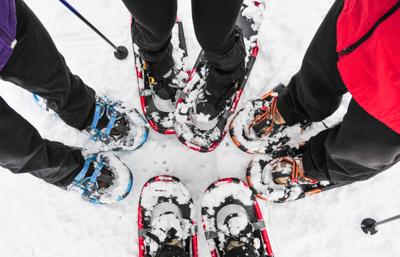Snowshoeing has become a popular recreational activity that serves as great winter exercise and allows people to enjoy hiking trails throughout the chilly winter months. It's also much less expensive than skiing or snowboarding, and is beginner-friendly.
Here are some tips that will help you have a great snowshoe experience:
1. Use the right type of snowshoe
You'll want to use the right snowshoes for your weight, the terrain, and the snow conditions. According to REI, flat terrain snowshoes make for great entry-level models that are designed for easy walking on flat to gently rolling terrain. Snowshoes of this nature tend to include a simple binding system, modest traction features, and no heel lift.
Meanwhile, rolling terrain snowshoes are designed to handle flat to moderately sloped terrain. They can have moderately aggressive crampon-style teeth for traction, a sturdy and easily adjusted binding system, and a heel lift.
If you're planning on snowshoeing steep and/or icy terrain, you'll want mountain terrain snowshoes. These snowshoes are complete with an aggressive crampon-tooth system for traction, a sophisticated binding system, and a heel lift for steep slopes.
2. Know the basic technique
On sloped terrain, the kick-step technique is helpful to implement. To use the kick-step technique, you'll pick up your foot and kick into the snow with the toe of your boot to create a step. The snowshoes will then be on the angle of the slope with the backs hanging downhill and the toes above your boots. This will plant the crampons or cleats into the snow under the balls of your feet. If the snow is crusty or hardpacked, you'll use the traction of your crampons or cleats and your poles. Also, be sure to use your heel lift on steeper slopes.
When coming downhill, keep your knees bent and relaxed and your body weight slightly back. Plant your heel first and plant your poles in front of you.
Stepping in snowshoes should be done with care, as the spikes and other traction devices on the bottom of the snowshoe can damage pant legs or cause injuries if they strike the leg.
Remember, snowshoeing can take longer than standard hiking to cover the same amount of terrain. Adjust your expectations with that in mind.
3. Wear suitable boots and socks
Snowshoes adjust to fit any type of boot, so the most important thing is to wear boots that keep your feet warm and dry. According to REI, insulated, waterproof winter boots with thick soles and rubber or leather uppers are best. However, waterproof all-season hiking boots work, as well. You'll also want wool or synthetic socks that wick sweat - and it never hurts to bring an extra pair.
A pair of gaiters can also be used to help keep snow out of boots.
4. Dress the part
As with all outdoor winter activities, you'll want to dress in layers. Start with a lightweight or midweight base layer, then a soft-shell jacket and pants, and finish up with a waterproof, breathable shell jacket and pants. A hat and gloves are also essential. As previously noted, gaiters can also be useful for keeping snow out of your boots.
5. Use poles
Poles will not only provide you with better balance – even on flat terrain, but can help give your upper body a workout too. Adjustable poles are usually best, as they can be shortened for uphill travel and lengthened for descending.
6. Prepare for adventure and pack the 'Ten Essentials'
It's always important to be prepared, especially if you're heading into backcountry territory. Make sure you've got the ten essentials with you, including a navigation device (map, compass, GPS device, etc.), headlamp, sun protection, first aid, knife, fire matches (lighter, tinder and/or stove), shelter, extra food, extra water and extra clothes. The items can be tailored to the specific trip you're taking.
Another important note is to make sure you let someone know where you're headed and when you expect to get back. This will allow for them to call for help if you're overdue.
7. Be aware of avalanche danger
Avalanches can happen on slopes steeper than about 30 degrees. According to the Colorado Avalanche Information Center, the best thing you can do before heading into the mountains is to check the avalanche forecast. You should also be able to recognize avalanche terrain, recognize signs of unstable snow, and carry avalanche rescue equipment.
When it comes to snowshoeing, traveling beneath steep slopes can be problematic. Remember – it's possible to trigger an avalanche from below or from a distance. Travel beneath steep slopes of snow on snowshoes has killed Coloradans before. This should not be taken lightly.
Learn more about avalanche safety here.
GET MORE NEWS: Sign-up for our FREE daily newsletter here







(0) comments
Welcome to the discussion.
Log In
Keep it Clean. Please avoid obscene, vulgar, lewd, racist or sexually-oriented language.
PLEASE TURN OFF YOUR CAPS LOCK.
Don't Threaten. Threats of harming another person will not be tolerated.
Be Truthful. Don't knowingly lie about anyone or anything.
Be Nice. No racism, sexism or any sort of -ism that is degrading to another person.
Be Proactive. Use the 'Report' link on each comment to let us know of abusive posts.
Share with Us. We'd love to hear eyewitness accounts, the history behind an article.